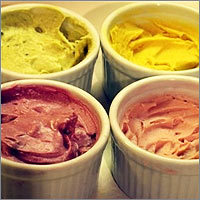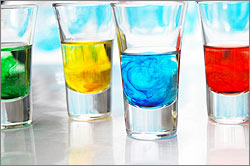Imagining food without any color in it is impossible ! Food would be so boring a thing without the exciting colors in it. Most of the kids are taught colors with fruits and vegetables. Red apples, orange oranges, yellow mangoes, green grapes, etc. Not just fruits, candies, ice creams, puddings, confectionary products and many other preparations appear so tempting due to their rich colors.
Colors actually make food appear good and more appetizing. Different food colors and dyes are included to add a zing to the food. All these food colors are food dyes and colorings that occur either naturally or are created artificially. In technical terms, a food dye is a food additive substance that is added to the food to change or improve the food color. It may or may not enhance the flavor of the the food, though. A number of food colors can be attained naturally from natural foods. For example, green color that can be obtained from chlorophyll and green tea, yellow color that can be obtained from benign yellow flowers, red color from carrots, cabbage or beetroot, deep purples, pinks, blues and more. Almost all colors can be found as natural food dyes in some form or the other.
But then we also have substitutes known as the artificial food colors. Artificial and synthetic food dyes are prepared artificially, packaged and marketed. Since extracting natural food dyes at home is a tedious effort, generally most people tend to go for the artificial food dyes. Each of the two types of food dyes are different in their properties and nature. Let’s understand each of them in a little more detail.
Natural Food Dyes

Talking about natural food dyes, as said before, they refer to food colors that are derived from different edible products. Some of the popular natural food colors are:
Caramel food coloring – Caramel coloring is made from caramelized sugar, used mainly for getting a brown a beige-brownish coffee color, in products like cakes, pastries, gravy, seasoning and sauces and sweet syrups.
Carmine food dye – Carmine food dye is red food dye derived from insects are is popularly used in candies, fruit fillings and dairy products.
Annatto extract – Annatto extract is the red food color derived from the annatto seeds.
Other similar natural color dyes and their sources are:
- Carmine blue
- Chlorophyll
- Black current
- Curcumin
- Grape
- Paparika
- Turmeric
But being natural food dyes does not mean that they are completely harmless. Many people suffer food dye allergies and intolerances with different food dyes. These natural food dye allergies may vary from minor to serious ones depending upon the individual intolerance levels. For example, a number of people are allergic and react to annatto food dye and carmine red food dye.
Artificial Food Colorings
Artificial food dyes are the ones that are artificially prepared to substitute for the natural food dye, or to create food colorings that cannot be found in the natural food coloring. Such colors usually carry harmful chemicals and complaints regarding their harmful effects have been a global phenomenon. People have suffered allergies and reactive intolerances due to harmful ingredients in artificial food coloring. The popular artificial food colorings are:

- Erythrosine
- Tartrazine
- Sunset Yellow
- Patent Blue V
- Allura Red Food Coloring
- Quinonline Yellow
- Fast Green
- Brilliant Blue
DL-Alanine powder supplier and manufacturer,
These artificial food colorings are put in plethora of food items specially the packaged ones. Ice creams, cakes, fruit drinks, seasonings, sauces, medicines, medicinal syrups, chips, cheese products and other packaged foods. But at the some time they have a number of side effects are allergic reactions associated with them. Research has proved that these dyes have both short term and long term adverse effects on young, old and kids alike. But since they are unavoidable. There heath hazards are showing in the shape of obesity, hyperactivity, lesser immunity levels and aggravated heath conditions like migraine, asthma and other problems.